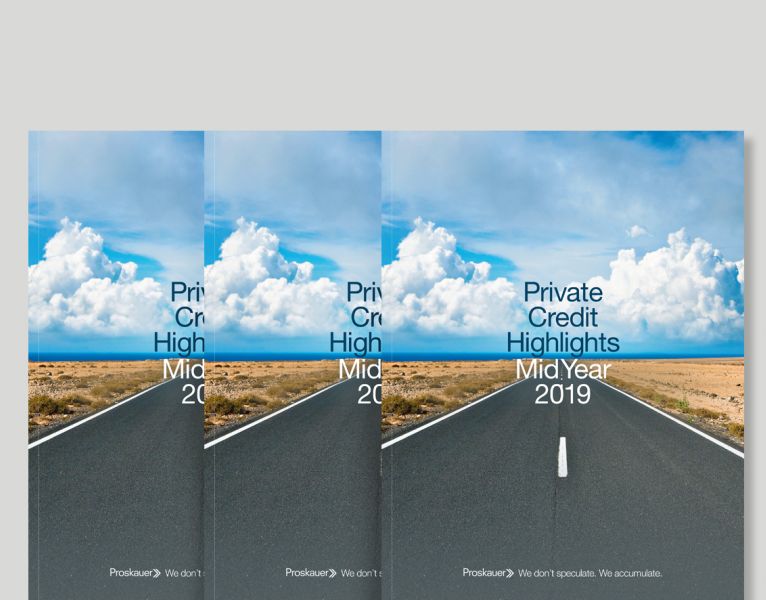Our private credit clients are preparing for the next restructuring cycle and have called us about ultrafast bankruptcy cases. These chapter 11 cases have grabbed headlines because they lasted less than a day. Specifically, FullBeauty Brands and Sungard Availability Services emerged from bankruptcy in 24 hours and 19 hours, respectively. Is this a trend and which companies are best suited to zip through chapter 11?
A. Prepacks, Pre-Negotiated Cases, and Free-Falls
Technically speaking, a speedy bankruptcy case is known as a “prepackaged” bankruptcy case (or a “prepack”). A prepack is a chapter 11 case where the borrower negotiates, drafts a chapter 11 plan, and solicits acceptances for the plan before the bankruptcy case is even filed. In contrast, a pre-negotiated case is one where the chapter 11 plan is negotiated before the filing with the company’s principal creditors, and the bankruptcy case is filed based upon a commitment to pursue and support confirmation of that plan (which is often attached as a term sheet to a restructuring support agreement). A filing without meaningful pre-bankruptcy preparation (including without a fully-baked plan or restructuring support agreement) is referred to as a “free-fall” or “naked filing” and is a disruptive way to start a bankruptcy case. According to an article published in the American Bankruptcy Institute, prepacks and pre-negotiated bankruptcy cases now represent the majority of all large chapter 11 filings, with 65% of large cases filed as prepacks or pre-negotiated ones, compared to 37% in 2010-15.[1]
A prepack offers many advantages. First, it is typically less expensive than a pre-negotiated or free-fall case, because the prepack case is shorter in duration and less contentious. Second, a prepack minimizes the bankruptcy stigma and business disruption, which minimizes the risk of losing trade credit, deterioration in vendor relationships, and employee departures. Finally, a prepack provides greater certainty to the residual stakeholders because the bankruptcy case is filed with a confirmable chapter 11 plan and, as is often the case, an unsecured creditors’ committee is not formed because unsecured creditors are unimpaired.
B. When is a Prepack a Viable Strategy?
In our experience, there are five key factors that impact the determination of whether a prepack is a viable strategy: (1) type of restructuring: balance sheet versus operational; (2) degree of creditor support; (3) public debt versus private debt; (4) liquidity; and (5) forum.
- Balance Sheet Restructuring. A prepack is best suited for an operationally sound business that needs to restructure by deleveraging its balance sheet. As a result, most prepacks involve the conversion of certain funded debt for reorganized equity while all other liabilities are left unimpaired, which means that those other creditors “ride through” a bankruptcy with their claims left unaltered. A distressed company in need of the “bankruptcy tool box” to address operational issues (e.g., rejecting numerous burdensome leases or modifying legacy liabilities) is not an ideal candidate for a prepack. That being said, a prepackaged chapter 11 case can still be successful even if it incorporates the bankruptcy tool box so long as it is done in a limited way and the process remains largely consensual. For example, in Sungard, the debtors rejected several contracts and the rejection damages claims were paid in full.
- Strong Creditor Support. A prepack is a viable strategy for a restructuring that has significant creditor support, which is often easiest to obtain when the debt is not widely held. Thus, a distressed borrower with funded obligations to a group of private creditor lenders in a club deal is better suited for a prepack as compared to a borrower with widely-held syndicated loans or bond debt. On a related note, prepacks are an effective strategy to bind minority holdouts to a restructuring that otherwise has strong creditor support. In a typical private credit loan, converting debt to equity is a “sacred right” that requires unanimous consent. By comparison, a consensual chapter 11 plan only requires the acceptance of each voting class, which means a majority of the voting lenders holding at least two-thirds of the debt in the class. When a borrower in the midst of an out-of-court restructuring anticipates a hold-out problem, it is not uncommon for the company to simultaneously pursue an out-of-court proposal with a back-up prepack to take advantage of the more liberal voting thresholds (a so-called “stapled prepack”).
- Private Debt. A prepack strategy works best if the debt being restructured is not public. Given the uncertainty as to whether Bankruptcy Code section 1145’s exemption from the securities laws applies to a prepetition solicitation of votes for a prepack, it is advisable that any pre-bankruptcy solicitation be structured to comply with U.S. federal and state securities laws. For public debt, public disclosure requirements and the delay and expense of the SEC registration process may foreclose the prepack option for a distressed company. However, when a debtor is restructuring private debt held by a relatively small group of investors, a prepetition solicitation is typically structured to be exempt from the registration requirements pursuant to Section 3(a)(9) or Section 4(2) of the Securities Act of 1933 and can be done in a quick manner with minimal SEC filing requirements.
- Liquidity. While prepacks have a short stint in chapter 11, there is substantial work required before the bankruptcy case is filed. It takes time for a proactive borrower to engage with its lenders, negotiate and draft the plan documents, solicit acceptances, and prepare the other papers necessary to commence a chapter 11 case. Thus, a successful prepack requires a company with sufficient liquidity to fund this process and the associated professional fee burn. Where the liquidity runway is insufficient, the existing lenders and/or sponsor may be reluctant to advance new loans outside of a DIP loan to allow for these negotiations to play out, especially when the outcome may be uncertain. The case of Monitronics is a good example. There, the prepackaged chapter 11 plan was confirmed 38 days after the petition date, but the restructuring was negotiated over the course of 18 months leading up to the filing.
- Forum. The final factor for an ultrafast prepack is the jurisdiction where the chapter 11 case is filed. Typically bankruptcy courts will confirm a prepack in 30 to 60 days. But, as we saw in FullBeauty and Sungard, some jurisdictions are willing to confirm a chapter 11 plan on the day the petition is filed where the company can demonstrate compliance with all applicable notice requirements. Notably, the Bankruptcy Court for the Southern District of New York confirmed the chapter 11 plans in both FullBeauty and Sungard in less than a day notwithstanding objections from the U.S. Trustee in both cases. To counter the objections of the U.S. Trustee, the debtors explained the exigent circumstances that weighed against prolonging the chapter 11 cases. For example, in Sungard, the debtors’ key customers indicated that they would defect to the debtors’ competitors if the debtors were to remain in bankruptcy. There was also a substantial risk that the debtors’ contractual counterparties in other countries would not grasp the unique protections afforded to debtors under the Bankruptcy Code. Although the court did not rely on such circumstances in its decisions, it is not clear whether other jurisdictions will similarly overrule objections filed by the U.S. Trustee or other parties in interest in the absence of any exigent circumstances.
C. What Happened in FullBeauty and Sungard?
The restructurings of FullBeauty and Sungard illustrate how these factors played out in practice. FullBeauty is a direct-to-consumer retailer in the plus-size apparel market. Its prepetition capital structure consisted of: an asset-based loan facility in the aggregate principal amount of roughly $144 million, including a first-in, last-out (FILO) tranche in the amount of $75 million; a first lien term loan in the amount of roughly $782 million; and a second lien term loan in the amount of $345 million. The first and second lienholders agreed to accept a combination of new term loans and reorganized equity in a restructuring that, among other things, resulted in a $35 million injection of new money and a reduction of existing secured debt by a total of $900 million. All other classes, including general unsecured claims, were unimpaired. The restructuring support agreement was signed by 99% of first lienholders and 95% of second lienholders. Ultimately, 100% of voting parties agreed to accept the plan.
Sungard is an information technology company that provides business continuity management software and disaster recovery services. Its prepetition capital structure consisted of: a secured revolving credit facility in the amount of $35 million; two secured term loans in the amounts of $421 million and $380 million; and unsecured notes in the amount of $425 million. Among other things, the Sungard plan converted (i) all $836 million in secured term and revolving loans into a $300 million new term loan and 89% of reorganized equity and (ii) all $425 million of notes into the remaining 11% of reorganized equity. All other claims of creditors were unimpaired, including general unsecured claims and rejection damages claims. The restructuring support agreement was executed by holders of roughly 75% of secured claims, holders of roughly 85% of unsecured notes, and the sponsors. As in FullBeauty, the plan was ultimately accepted by 100% of voting parties.
D. Practical Insights
We believe that the trend of chapter 11 cases filing as prepacks or pre-negotiated ones will continue in the next restructuring cycle. This is especially true in private credit deals because (a) most of the borrowers are sponsor-backed private companies, (b) funded debt is not widely held, (c) private credit lenders often have long-standing relationships with the equity sponsors across multiple credits and platforms, (d) the administrative and professional fee burn associated with a free-fall case can substantially impair recoveries, and (e) private credit lenders have the dry-powder and restructuring flexibility to convert their debt to equity and take control of an over-leveraged business, albeit often as the exit strategy of last resort. Consequently, stakeholders in distressed private credit deals may be better able to reach consensus for a commercial solution around a conference room table that maximizes value and preserves the going concern. While not every distressed situation will fit this paradigm, a “speedy” chapter 11 case may be a viable strategy for private creditors to maximize their recovery.
[1] See John Yozzo and Samuel Star, “For Better or Worse, Prepackaged and Prenegotiated Filings Now Account for Most Reorganizations,” ABI Journal, November 2018, available at abi.org/abi-journal.





